 | Time 1hr: A simple activity designed to get students to reach for their knowledge of triangle geometry. Pythagoras's theorem, SOHCAHTOA, Sine rule and Cosine rule. The activity provides an excellent opportunity for giving meaning to and practising these concepts. |
 | Time 1hr: A simple activity designed to get students to reach for their knowledge of properties of angles and shapes. Students are given a number of diagrams and asked to debate and conclude about whether or not they can actually exist. Great exercise in using reasoning and applying knowledge. |
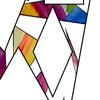 | Time: 1-2hr By copying and pasting multiple triangles students experiment with what quadrilaterals, and polygons, can and can’t be made with different triangles. They then classify triangles using a flowchart, before creating their own flowchart to identify the special quadrilaterals. The activity closes with a triangular jigsaw puzzle that students have to fit into a sheet of quadrilaterals then, a work of art! |
 | Time 1-2 hrs: This activity is about understanding the properties of quadrilaterals. A far deeper understanding is gained if we can use them to construct the shapes themselves. This is a real challenge, but the scaffolding provided in this activity enables the students to do it. Computer required. |
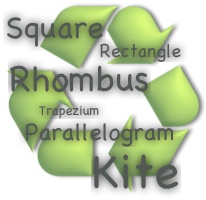 | Time: 1-3hr This activity is all about establishing and working with the defining properties of quadrilaterals. Students work with dynamic constructions and move them around to try and establish what is always, sometimes and never true about them so that they can identify wich shape it is. Students are then invited to construct their own before working on problems about the sets and subsets. |
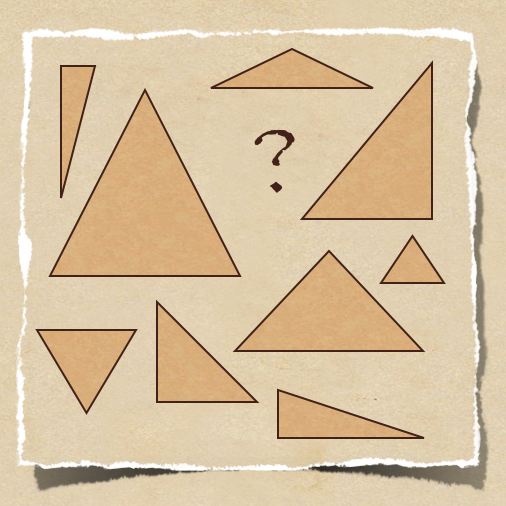 | Time: 1 hr+ A great triangle mystery! These 24 triangles can be split in to 8 groups of 3 similar triangles by matching the angles. Students can use proportional reasoning to work out the missing lengths on the similar triangles. Present the triangles and say 'Find out the missing lengths' or add some structure depending on the class. The activity can be extended in to Pythagoras's theorem and trigonometry. |
 | Time 2 - 3 hrs: Students explore the conditions for congruency of triangles by constructing giant triangles with playground chalk and testing conjectures. The activity is then backed up with a thought provoking paper based challenge. Great practical lesson with rich possibilities. |
 | ime: 1-2hrs Students explore the rotational and reflective symmetry occurring in nature and have fun producing their own flower symmetry patterns. This instantly engaging activity makes use of dynamic geometry software geogebra which is freely available requiring no software installing at  geogebra.org geogebra.org |
 | Time 30m: This is a lovely Christmas activity! Students are asked to make some beautiful snowflake images using dynamic software. They can then share their work with the world by adding their snowflake to collaborative presentation. Why not run a competition in your school for the best image? |
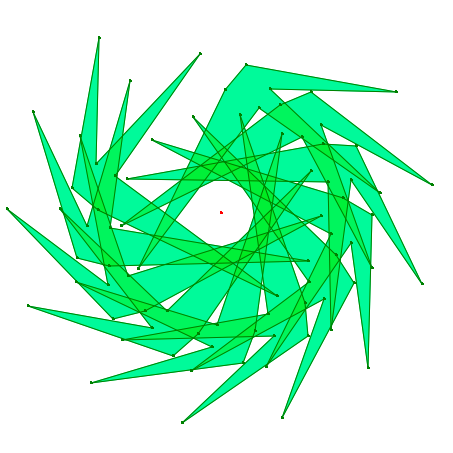 | Time: 1 hr+ Explore the concept of rotation with this dynamic problem. Students are shown an animation created from a construction in dynamic geometry and asked to recreate it by examining its properties. The construction is all based on repeated rotation. This is an absorbing problem combining some critical thinking with creativity. |
 | Time: 2hr This activity gets students to discover the formula for the sum of interior angles in polygons. The investigation can be completed using dynamic geometry software and is followed by an opportunity to justify the results geometrically in two different ways. Finally, it is completed with a lovely application using knowledge of interior angles to create semi-tessellations. A very complete resource. |
| Polygons and Stars |
| Polygon Proofs |
| Circle Theorem |
 | Time 1-2hrs Ideal for Christmas celebrations, this activity gets students to design and create Platonic and Archimedean polyhedra and make them into decorations. No messy glue is required, as tabs are folded and stapled on the outside, making them easy and quick to make, as well as attractive and decoratively original. The shapes are strong enough to be made on paper, although using coloured paper makes them even more attractive.There are suggestions to get started, but the nets are not provided for the students, as such they will have to think carefully about the number of shapes they will need and how they will fit together. The Archimedean solids (semi-regular polyhedra) require two or more different shapes to fit together. To this end, dynamic geometry software, like freely available Geogebra could be used to construct polygons. Students will love the beautiful results and could be encouraged to search for Euler’s Characteristic. The names of the polyhedra are purposely not mentioned in this activity to enable students to discover the nets for themselves. |
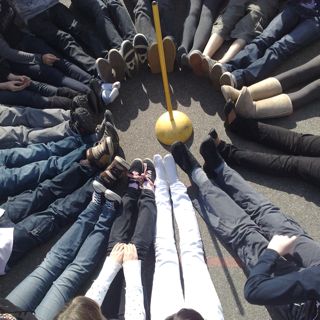 | Time: 2 hrs A chance to get your class outside, Human Loci is a fun and revealing activity that gets students representing various loci by positioning themselves according to the rules given. Best played in teams! |
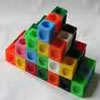 | Time: 1h This activity uses the excellent Freudenthal Institute's Wisweb interactive "Rotating and Building Houses" to help students develop their ability to visualise 2D representations of 3D shapes. The activities on this page are carefully designed to get the most out of the virtual manipulative, with students using it to test their 2D written representations (digitally in word) in a 3D environment and to set challenges for their partner to solve. |
 | Time: 1-2hr In this activity students are set the task of producing their own logo for the Olympic Games. The initial challenge is to create four beautiful dynamic images using dynamic geometry. Students are led through each construction with individual help videos to get to grips with the equation of circles, controlling the centre, radius and path of the circles. Opportunities for a class competition. |
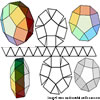 | Time 1h The aim of this resource is to develop student’s association of nets, hence surface area, with 3D solids, hence volume. The activity starts with a matching activity, nets and solids, some of which work, some don’t, students can cut and fold to check. Two virtual manipulative websites are then used, one aimed at inspiring them with a wide, and unusual range of 3D shapes. |
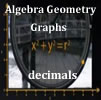 | Time: 1h What changed during the Renaissance? This activity looks at the revolution in using algebra to describe geometries, graphs, 3D perspective and the introduction of decimal notation. It can be used as part of a Renaissance School Day where students make links between subjects and then present their findings in a whole school assembly. Overview of this day, lead by History department, available here. |















